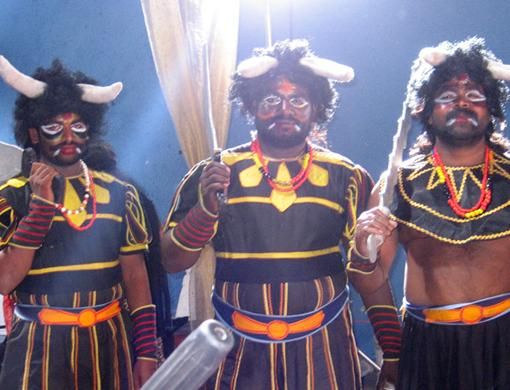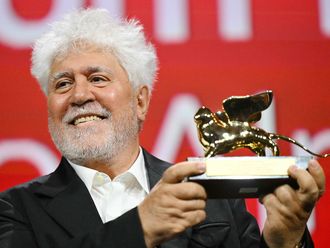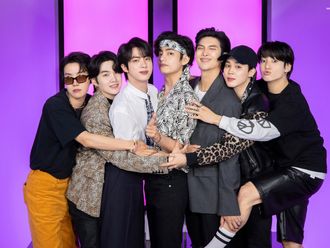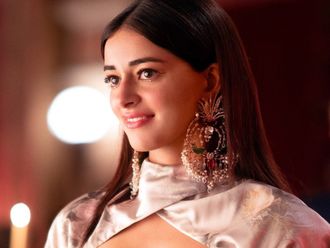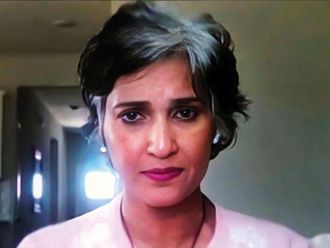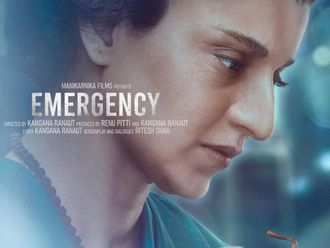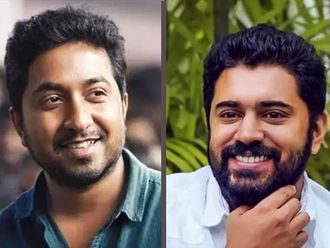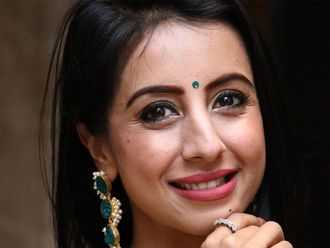Past a neighbourhood teeming with wig shops, tailors, storefront astrologers and beauty salons and through an iron gate sprawls one of the largest and perhaps wackiest film studios in India.
Just before noon, a very large, fierce-looking creature strolls by. His face is bright blue. He is bare-chested. His hair is fluffy and moulded into what can only be described as unruly man ponytails.
He is the main hero of an upcoming religious film. He plays Krishna, a Hindu deity known as Blue Boy and portrayed variously as a prankster, a wonderful lover and a divine hero.
Dozens of women draped in red saris rush forward. They giggle and then join a huge crowd that includes make-up and hair artists, stagehands, tea sellers, stuntmen and women selling strings of fresh jasmine to weave into the hair of actresses.
This is one of India's busiest film sets. But it is not in glittery Bollywood, based in Mumbai. This is Kollywood, the lesser-known Tamil-language industry named for the Kodambakkam neighbourhood of Chennai.
“We like a lot of people involved in our movies — hundreds, thousands even,'' says Prabakaran, 42, an art director who goes by one name, as hundreds of workers quickly erected a set 28 feet tall, where the film's heroes will fight it out on ladders in a Tamil style of martial arts.
About 12.30pm, lots of stray pieces of iron and wood come crashing down. A porter suffers a small leg wound but everyone else is OK.
Most of the workers say they love their jobs because sometimes they get to glimpse an actor.
Kollywood stars are treated like deities, featured on larger-than-life cardboard cutouts in nearly every neighbourhood and village.
The male stars have deadly hairdos — ink dark-skinned guy with a sun-yellow or perhaps blue-bleached mullet.
The films have two basic plot lines: fighting or flirting. It is not uncommon for one hero to take on an entire motorcycle gang and emerge without any injuries. They love freeze frames. And zooms.
“And slow-mo,'' Prabakaran says. “These days, we are improving our technical side. We are learning from world cinema since we see it now on satellite TV. To be very frank, we needed some updating.''
The male heroes are often pot-bellied, double-chinned everymen, such as Kollywood's superstar Rajinikanth, the main man in last year's blockbuster Sivaji.
It was shot here at AVM Studios, amid the sets of fake bus stops and cardboard-and-brick Mogul palaces and it turned out to be the most expensive film in Indian history.
Rajinikanth, once a bus conductor in Bangalore, became the highest-paid actor in India. (He is also a huge draw in Japan and Germany.)
Before a film, fans pour milk over cutouts of Rajinikanth, in a Hindu rite of worship usually reserved for a deity.
“Maybe he will come today. We are never sure,'' says Saravanan, 40, a director who also goes by one name, wearing a Che Guevara medallion around his neck.
“We are not very systematic here. People come. We film. This is not the army. We can't really categorise what we do.''
His film will be a revenge story just as The Godfather but a musical with extended Matrix-like fight scenes.
At 1pm, dancers are rehearsing their lightning-speed hip-shaking, shoulder-shrugging moves and the stuntmen are practising swallowing smokes or putting ten to their lips at once.
Kollywood, which released more than 107 films last year, is booming. Some film critics say the reason is that Bollywood is losing fans as its plots become too Westernised and focused on characters with glamorous lives that most people in small-town India can't relate to.
“Our stars are still chubby, they are still the people you meet in your life,'' says Uma, an actress, fastening a long fake braid to her cropped hair to create a style commonly worn in small towns.
At nearly 2pm, about 100 people crowd on to a set that the actor playing Krishna has just entered, his face freshly coated blue.
A director climbs aboard his crane camera, yells, “Silence!'' and begins to film. Many women rush to the stage to dance.
Madari Nice, a white-haired actress who will play a hysterical mother in the film, smiles as hundreds of extras wait to be chosen for a scene.
Many of them have just shown up, on the chance that an actor will get sick or a dancer will hurt an ankle.
“I have been in 1,000 Tamil films,'' Nice says, not uncommon in an industry in which dozens of movies are pumped out every few months. “Every time, it's a wonderful adventure.''


